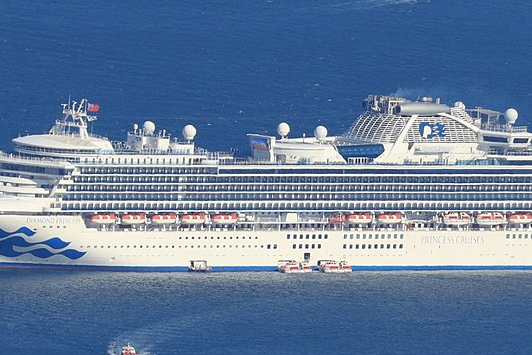Diamond Princess’s Contribution to Science

The beautiful cruise ship seen in this picture has been in the top trending world news for the past 3 months, and in the coming years may become the subject of books and film like other ships that have left their mark on history, such as the St. Louis, Struma, or Wilhelm Gustloff. Yes, I'm talking about the Diamond Princess, which became famous due to the 2020 COVID-19 pandemic. This ship, which was built in Nagasaki in March 2004 and has a capacity of 2,670 passengers, was sailing a cruise between Japan and Australia as usual when an 80-year-old passenger developed shortness of breath and fever on January 20, 2020, upon which the ship docked in the port of Hong Kong, dropped off this passenger, and continued its journey. A few days later, it was discovered that the passenger had COVID-19 pneumonia, which the world had not taken seriously up to that point, but when the ship docked in the port of Yokohama on February 5, 2020, the difficult life of quarantine began for the 3,711 people on board. How those on the ship spent their days in quarantine, the difficulties they struggled with, the emotional states of those mostly elderly people and their relatives, if they are one day written down, will surely interest a Hollywood screenwriter. We, as physicians, are more interested in the scientific aspect of the situation.
Although nearly 4 months have passed since the day the disease was first reported in the Chinese city of Wuhan, there are still many things we do not know related to the COVID-19 pandemic. The most important of these is undoubtedly the mortality rate of the disease. Reported mortality rates associated with COVID-19 pneumonia are in the 2–4% range. Although the differences in reported values may not seem major, 4 is still double the value of 2, and this corresponds to a difference of 20,000 deaths in a group of 1 million. Knowing the actual mortality rate is essential for us to understand the strength of the enemy we are facing as a global community and to determine the measures we will take. So, how accurate are the current data regarding mortality rates?
Calculating the mortality rate of a disease is very easy, you divide the number of people who have died from this disease by the number of people affected. We more or less know the number of deaths associated with COVID-19, but determining the size of the affected population is not that easy because a very large proportion of those infected can be asymptomatic. If only we had a cohort of well-tested and closely monitored individuals of significant size, about 3000 to 4000, perhaps? Yes, dear friends, the Diamond Princess is a nearly ideal cohort. The 3,711 people on board were tested several times. Data obtained on February 21, 2020, 16 days after the start of the quarantine on February 5, 2020, has been scientifically analyzed and published by Mizumoto et al. Of the 3,711 people on board, 3,063 were tested ideally and repeatedly. Of these 3,063 people with definitive test results, 634 were diagnosed with COVID-19. Of these, 476 were over the age of 60, which is the riskiest age group in terms of mortality. Nearly half (n=306) of the 634 patients were asymptomatic. In fact, asymptomatic patients were the focus of the Japanese team that conducted this study, which was published on March 12.
The latest data on the mortality rate of the disease, which is what we are concerned with, comes from an evaluation on March 3 of the status of all the passengers on the ship. This assessment showed that only 6 deaths in total occurred on the ship. Six deaths among 634 patients. In other words, less than 1%. Moreover, this value comes from a cohort in which about 75% of the subjects are over the age of 60, and most of which had lived in less-than-ideal quarantine conditions, in cabins that do not receive sunlight and with relatively limited nutrition.
I hope those who someday write the story of the Diamond Princess also mention this “small” contribution she made to science. One last word to my colleagues who may be interested in cruise holidays: This epidemic is not the first incident to afflict the Diamond Princess. In February 2016, a norovirus outbreak occurred among 158 passengers on board, causing the ship to docked in the port of Sydney. But that story is for another article...
I wish you all health and plenty of travel…
Hakan Özdemir MD.
April 3, 2020
References
- Mizumoto K, Kagaya K, Zerabski A, et al. Estimating the asymptomatic proportion of coronovirus disaese 2019 cases on board the Diamond Princess cruise ship, Yokohoma, Japan, 2020. Eurosurveillance 25;10: March 2020.
- Frias L. Six people from the Diamond Princess cruise ship have died from the coronovirus. Business Insider March 3, 2020.




